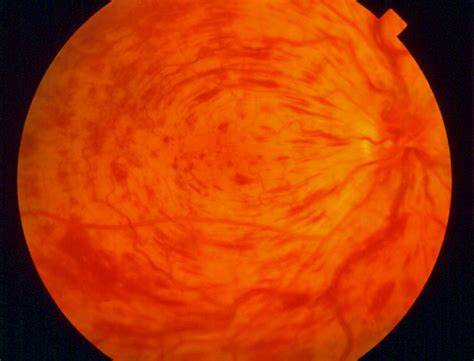Makindo Medical Notes"One small step for man, one large step for Makindo" |
|
|---|---|
| Download all this content in the Apps now Android App and Apple iPhone/Pad App | |
| MEDICAL DISCLAIMER: The contents are under continuing development and improvements and despite all efforts may contain errors of omission or fact. This is not to be used for the assessment, diagnosis, or management of patients. It should not be regarded as medical advice by healthcare workers or laypeople. It is for educational purposes only. Please adhere to your local protocols. Use the BNF for drug information. If you are unwell please seek urgent healthcare advice. If you do not accept this then please do not use the website. Makindo Ltd. |
Retinal Vein Occlusion (CRVO)
-
| About | Anaesthetics and Critical Care | Anatomy | Biochemistry | Cardiology | Clinical Cases | CompSci | Crib | Dermatology | Differentials | Drugs | ENT | Electrocardiogram | Embryology | Emergency Medicine | Endocrinology | Ethics | Foundation Doctors | Gastroenterology | General Information | General Practice | Genetics | Geriatric Medicine | Guidelines | Haematology | Hepatology | Immunology | Infectious Diseases | Infographic | Investigations | Lists | Microbiology | Miscellaneous | Nephrology | Neuroanatomy | Neurology | Nutrition | OSCE | Obstetrics Gynaecology | Oncology | Ophthalmology | Oral Medicine and Dentistry | Paediatrics | Palliative | Pathology | Pharmacology | Physiology | Procedures | Psychiatry | Radiology | Respiratory | Resuscitation | Rheumatology | Statistics and Research | Stroke | Surgery | Toxicology | Trauma and Orthopaedics | Twitter | Urology
⚠️ Central Retinal Vein Occlusion (CRVO) is an ophthalmic emergency. 👁️ Patients must be urgently reviewed by ophthalmology to exclude other acute causes of visual loss and to guide management. Visual prognosis depends on the degree of ischaemia and complications such as macular oedema and neovascularisation.
About
- Venous outflow obstruction of the central retinal vein → retinal ischaemia & oedema.
- May occur due to thrombophilia or compression by adjacent arteriosclerotic artery.
- Common cause of painless monocular visual loss in older adults.
Aetiology
- Compression of vein by arteriosclerotic central retinal artery (shared adventitia at lamina cribrosa).
- Thrombus formation → stagnation of blood flow, venous congestion, ischaemia.
- Visual loss due to macular oedema or retinal neovascularisation.
Risk Factors (Arteriosclerotic & Haematological)
- 🩸 Hypertension, diabetes, hyperlipidaemia.
- 🚬 Smoking.
- 👁️ Glaucoma (raised intraocular pressure).
- 🧪 Hyperviscosity states: polycythaemia, multiple myeloma, Waldenström’s macroglobulinaemia, leukaemia.
- 💉 Thrombophilia, esp. in patients <50 yrs.
- Inflammatory eye disease (rare).
Clinical Presentation
- ⚡ Painless monocular loss of vision (may be sudden or progressive).
- Fundus findings:
- “Blood and thunder” appearance → widespread flame-shaped haemorrhages.
- Cotton wool spots, dilated & tortuous veins.
- Macular oedema, swollen optic disc.
- History: ask about vascular risk factors, malignancy, personal/family history of DVT/PE.
Florid Haemorrhages and Dilated Veins

Differential Diagnosis
- Central retinal artery occlusion (CRAO).
- Retinal detachment.
- Migrainous aura with transient visual loss.
- Optic neuritis (esp. if painful visual loss).
Investigations
- 🧪 Bloods: FBC, ESR, U&E, glucose, lipid profile.
- ECG ± echocardiogram if cardiac risk factors.
- Thrombophilia screen if age <50 or no risk factors.
- OCT (optical coherence tomography) to assess macular oedema.
- Fluorescein angiography (ophthalmology) to grade ischaemic vs non-ischaemic CRVO.
Management
- 📉 Risk factor optimisation: treat hypertension, diabetes, lipids; smoking cessation.
- 💊 Consider low-dose Aspirin (75 mg OD) for vascular risk reduction.
- 👁️ Ophthalmology-directed:
- Intravitreal anti-VEGF (e.g. ranibizumab, aflibercept) for macular oedema.
- Intravitreal corticosteroids (e.g. dexamethasone implant) if VEGF unsuitable.
- Laser photocoagulation if neovascularisation develops (to reduce risk of neovascular glaucoma).
- 🔎 Monitor for complications: rubeotic/neovascular glaucoma, vitreous haemorrhage, retinal detachment.
References
🧾 Clinical Case 1 – CRVO (Ischaemic Type)
A 72-year-old man with poorly controlled hypertension and type 2 diabetes presents with sudden painless loss of vision in his left eye. Fundoscopy shows a classic "blood and thunder" appearance with widespread retinal haemorrhages, cotton-wool spots, and optic disc swelling. 👉 Diagnosis: Ischaemic CRVO. 👉 Management: urgent referral to ophthalmology for anti-VEGF therapy, pan-retinal photocoagulation if neovascularisation, and systemic risk factor control.
🧾 Clinical Case 2 – CRVO (Non-Ischaemic Type)
A 60-year-old woman with a history of glaucoma and hyperlipidaemia complains of blurred vision and floaters in her right eye, but no complete visual loss. Fundoscopy reveals venous engorgement, scattered retinal haemorrhages, and macular oedema. 👉 Diagnosis: Non-ischaemic CRVO. 👉 Management: anti-VEGF injections for macular oedema, regular monitoring for progression to ischaemic CRVO, and treatment of underlying glaucoma and dyslipidaemia.